Buying table tennis balls sounds like an easy task, but surprisingly, it could get tiring as the market is flooded with numerous options. For starters, it is advisable to familiarise with the official requirements of the International Table Tennis Federation (ITTF) before choosing the right ball.
These rules dictate that the ball must be spherical, with a diameter of 40mm and weigh 2.7g. It further indicates that the ball must be made of celluloid or similar plastic material and be either white matt or orange matt.
You also need to understand why you want to acquire table tennis balls. There are different balls recommended for various needs. There are those suitable for training, competition, or leisure play.
To further help with the dilemma that comes with purchasing table tennis balls, let's look into the various types of balls available in the market and other factors you will need to consider before buying table tennis balls.
Types of Table Tennis Balls
New Plastic (40+)
The new plastic (40+) balls are made from Acrylonitrile Butadiene Styrene (ABS). This material is believed to offer improved roundness and durability compared to those made from Polystyrene (Poly balls) — it is also more environmentally friendly.
The 40+ inscription shows that the ball diameter is above 40mm, with a difference of up to 0.5mm. If you are looking to go into a match play, consider getting this type of table tennis ball.
Celluloid (40)
These table tennis balls are made of celluloid material and have a diameter of 40mm. They were used for ITTF competitions until 2014, when new laws were introduced, giving rise to plastic balls.
Celluloid balls are the most durable. If you are looking for a ball for normal play, you could settle for this option.
Training Balls
Training balls are softer and may break if they are stroke hard. They are best suited for beginners or child play.
One Star Balls
Balls classified as one star are softer and may break when hit hard. Nonetheless, if these balls are either white or orange and matt with a diameter of 40mm and weighing 2.7g, they will be acceptable by ITTF to be used in competitions.
These table tennis balls are cheaper compared to the rest. They are a good fit for leisure play or kids at school.
Two Star Balls
Two-star balls are not of the best quality in the group either, but they are better than one-star balls. Although they fail to meet all the standard requirements for a three-star rating, they would be a good alternative for three-star balls. They are recommended for non-competition play, too.
Three Star Balls
Three-star balls are of the highest standards and are the most durable. They meet all the requirements set by the ITTF. If you are looking for a table tennis ball for professional use, this would be your best pick.
Other Things to Consider
Colour
There are not many colours to play around with since the colour of the table tennis ball must be within the specifications set by the International Table Tennis Federation (ITTF). As mentioned earlier, the rules dictate that the ball must be either white matt or orange matt.
Consider choosing a colour that contrasts the most with your environment.
Weight
To be on the safe side, the weight of the ball you are getting must meet the standard weight requirement of 2.7g.
Player Ability
-
Beginner: If you are just getting started, you do not have to acquire a table tennis ball that is ITTF approved. Feel free to go easy.
-
Intermediate: At this level, you may consider what the law stipulates, but there is still no pressure. You could settle for the ball you want.
-
Expert: It is recommended that experts use the three-star balls used in competitions and tournaments organised by ITTF. However, if you are merely training or practising, you could explore other options available in the market.
Style of Play
If you are a beginner or just playing for recreation, you could get something more suitable for you instead of going by the official rules. You should also know that celluloid table tennis balls are deemed faster compared to balls made of plastics.
Stamp
The stamp on the Ping-Pong ball must include the ITTF approval, which may be indicated by the initials ITTF. There may also be a logo, the brand name, the 40 mark, or 40mm for celluloid balls and 40+ for plastic balls.
Hardness
For international competitions, the ball's hardness is measured in an automated computerised process. However, if you are not looking to compete, note that the softer the ball, the more susceptible it is to breaking.
Warranty
The ball you are getting must come with a warranty. It may help you get value for your money.
Your Budget
There is always something for every pocket. Knowing how much you can spend in making this purchase will help limit your choices to only what is within your budget.
Table Tennis Maintenance
Once you’ve purchased your table tennis ball, it is wise to take good care of it. After several plays, your ball is likely to be scuffed from contact and will need to be cleaned. Clean the ball to preserve the surface texture.
When cleaning, do not use detergents or scrubs. Instead, go for a sponge and plain water. Dip the sponge in the water and squeeze out excess water, then gently buff away the scuff on the ball in circular motions until you have covered the entire ball. Rinse off the ball and allow it to air dry before storing.
Also, ensure it is stored away from direct sunlight because UV rays can damage both plastic and celluloid materials.

